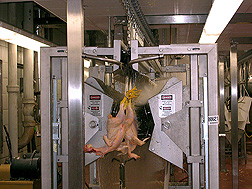This page has been archived and is being provided for reference purposes only. The page is no longer being updated, and therefore, links on the page may be invalid.
Read the magazine story to find out more. |
|
Progress Made in Reducing Campylobacter in Poultry
By Sharon DurhamFebruary 17, 2006
Agricultural Research Service (ARS) scientists have identified and investigated two “hot spots” in poultry production where contamination with Campylobacter bacteria may occur.
Campylobacter are foodborne pathogens that can be present in raw or undercooked poultry. These bacteria cause mild to severe diarrhea and fever in humans, and can sometimes result in the secondary, neurological condition known as Guillian-Barre syndrome. Since these bacteria are commonly found in the digestive tracts of swine, cattle and poultry, they’re readily deposited onto trucks and trailers when the animals are transported to processing plants. Getting live poultry to processing plants also involves confining the birds in transport coops for long periods.
It’s possible to reduce Campylobacter during poultry transport and processing with simple measures. But “simple” doesn’t always translate into “immediately feasible.”
Microbiologist Mark Berrang, in ARS’ Bacterial Epidemiology and Antimicrobial Resistance Research Unit, and food technologist Julie Northcutt, in the ARS Poultry Processing Research Unit—both at Athens, Ga.—have evaluated the role of transport coops and carcass defeathering as critical points at which Campylobacter contamination of broilers and broiler carcasses occurs.
The research team found that feces from Campylobacter-positive birds can contaminate the feathers and skin of Campylobacter-negative birds later placed in the same soiled transport coop. Allowing the coops to dry for 48 hours before reuse dramatically lowered Campylobacter numbers.
But since this approach is economically and logistically impractical, the scientists plan to explore ways to redesign the coops to make them easier to clean. According to Berrang, washing coops with water and disinfectant can reduce the Campylobacter levels, but it isn’t reliable and doesn’t eliminate the microbes.
The second critical contamination point occurs during an early step in processing—feather removal. While, overall, processing decreases Campylobacter numbers on carcasses, this step increases them. To control the microbes, processors must work against this jump in numbers throughout the rest of processing. Berrang and Northcutt have shown that the Campylobacter increase is caused by the escape of highly contaminated fecal matter from the birds’ lower gut during feather removal. They are now investigating methods to minimize this source of contamination.
Read more about this research in the February 2006 issue of Agricultural Research magazine.
ARS is the U.S. Department of Agriculture’s chief scientific research agency.

